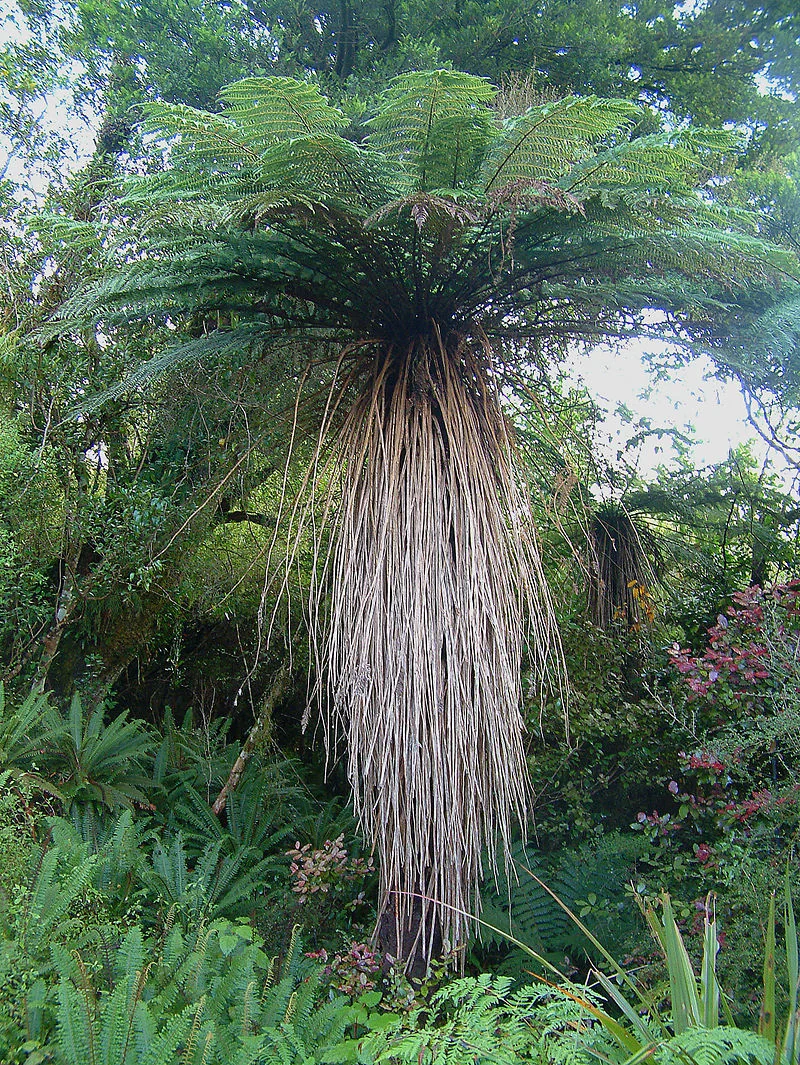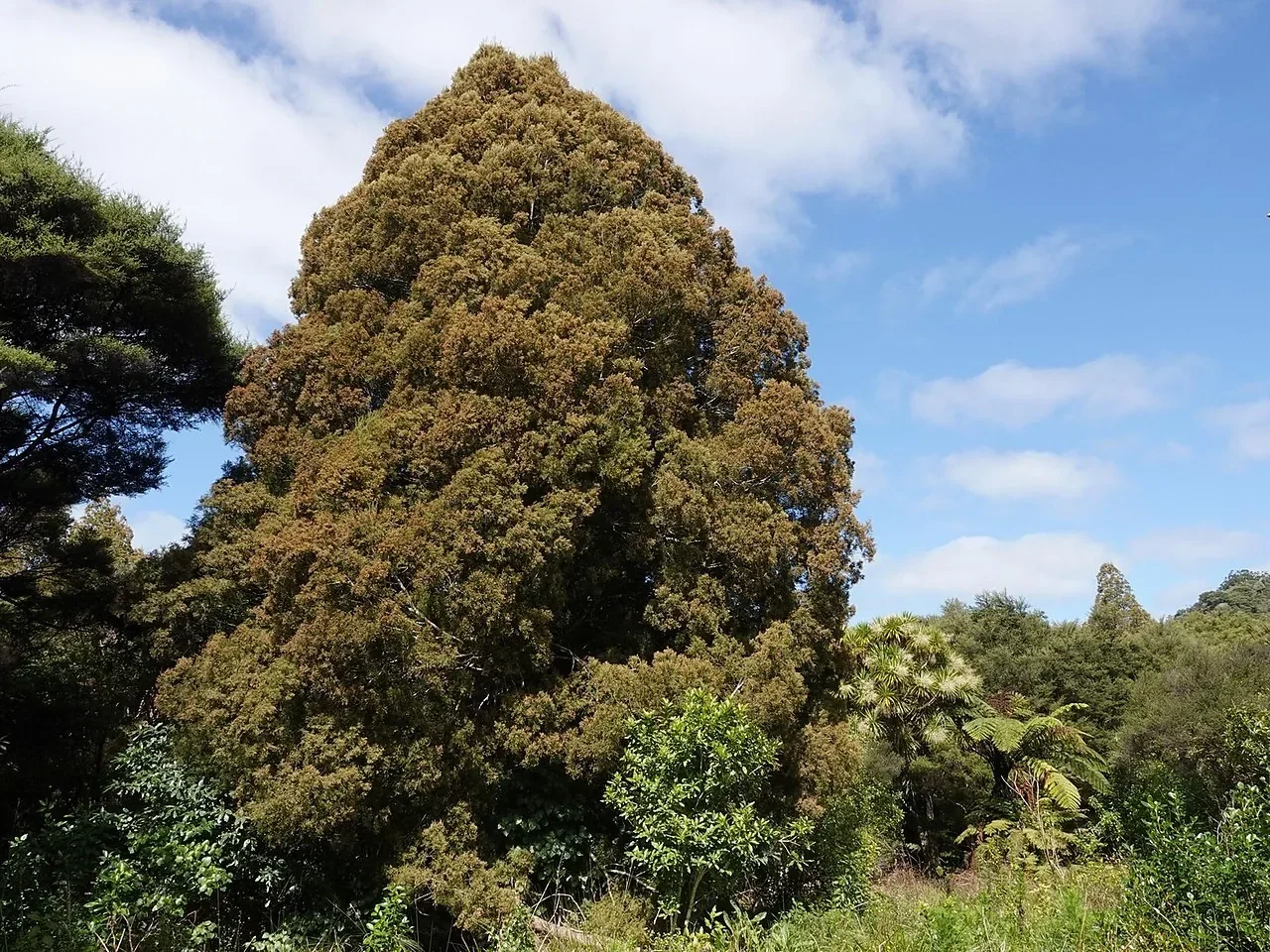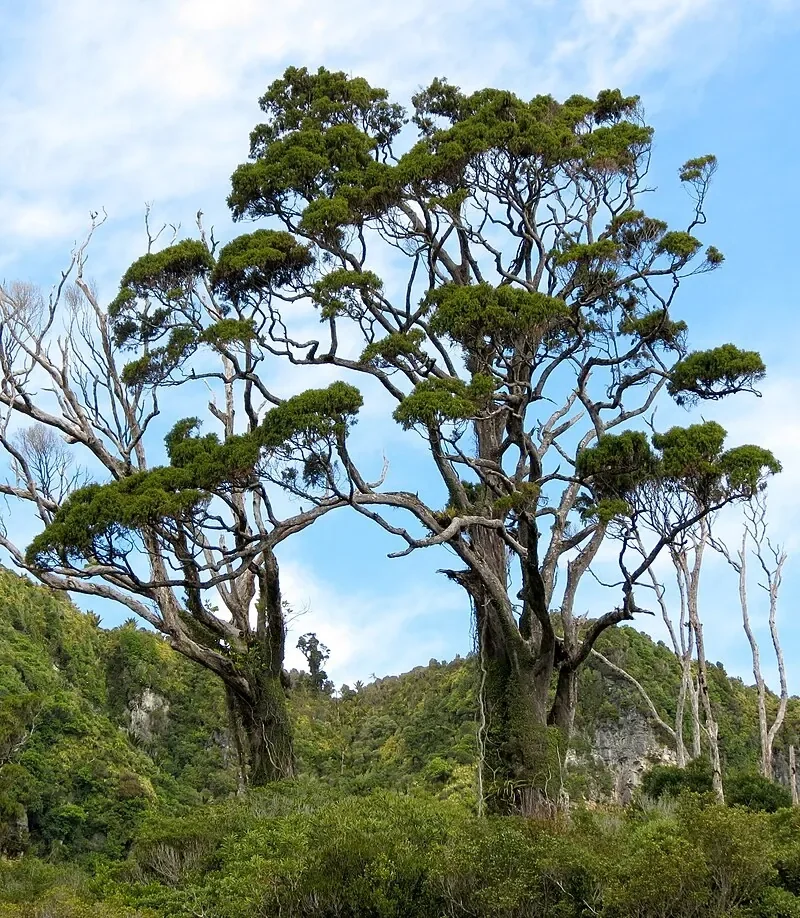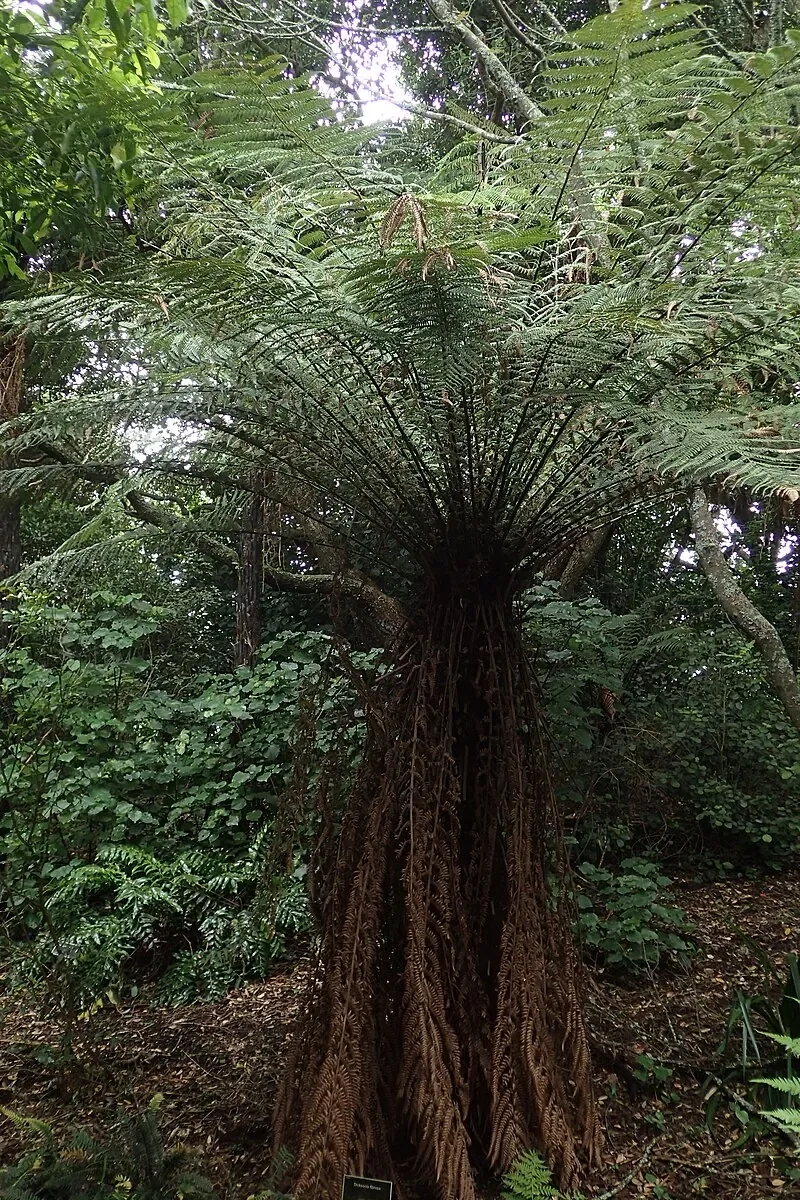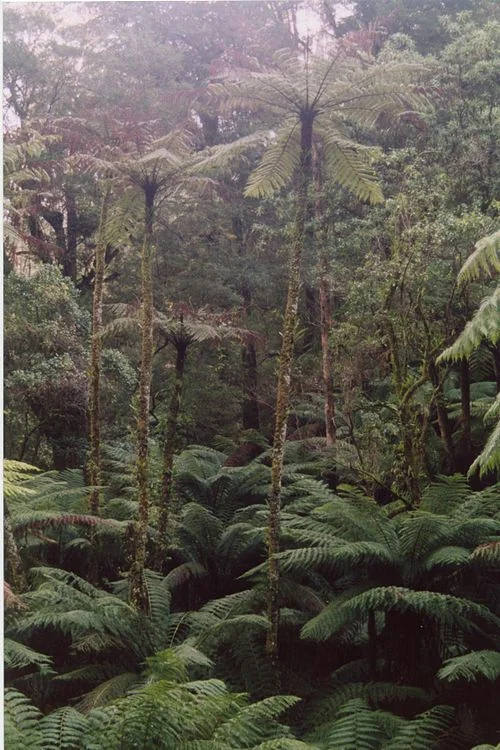
Gully Tree Fern
Cyathea cunninghamii
Gully Tree Fern (Cyathea cunninghamii) stands as one of New Zealand's most elegant and distinctive tree ferns, creating cathedral-like groves in the moist, sheltered valleys and stream-side gullies where it naturally thrives. This graceful giant can reach remarkable heights of up to 20 meters, with its characteristically slender trunk - typically just 8-10cm in diameter - creating an almost impossibly delicate appearance for such a tall plant, crowned by a relatively compact canopy of intricately divided fronds. The species represents a living link to ancient Gondwanan forests, having evolved over millions of years to perfect its adaptation to New Zealand's humid, temperate conditions. Its soft-textured fronds, measuring 1.5-3 meters in length, display the classical three-times-divided pattern typical of advanced tree ferns, creating an intricate lacework of pinnules that filter dappled light down to the forest floor below. The fern's most remarkable feature lies in its reproductive structures - distinctive cup-shaped protective membranes called indusia that house the spore clusters, creating tiny jewel-like formations on the underside of fertile fronds. Found naturally in the damp recesses of coastal and lowland forests throughout New Zealand and parts of Australia, this species demonstrates remarkable ecological specialization, requiring the constant humidity and protection from wind that characterizes its preferred gully habitats. The Gully Tree Fern plays a crucial role in forest ecosystems, providing shelter for numerous smaller fern species, mosses, and epiphytes, while its decaying fronds contribute vital organic matter to the forest floor. Its presence often indicates high-quality, undisturbed forest habitat, making it both an indicator species for conservation efforts and a living monument to New Zealand's prehistoric past, when giant ferns dominated landscapes across the ancient supercontinent.

Plant Description
Botanical Features
Cyathea cunninghamii, commonly known as the Gully Tree Fern or Slender Tree Fern, is a tall tree fern native to New Zealand and parts of Australia. It has a slender, erect trunk that can grow up to 20 meters tall and typically ranges from 3 to 15 cm in diameter, often covered with persistent stipe bases in its upper parts. The fronds are 1.5 to 3 meters long, forming a relatively small crown, and are typically dark green above and paler green below, with a soft texture. They are 3-pinnate (divided three times). The stipes (frond stalks) are short, coarse, black, and dull, with numerous small, sharp tubercles. The sori (clusters of spores) are conspicuous, globose, and arranged in rows on the lower surface of the pinnules, covered by a cup-shaped indusium. This tree fern typically grows along creeks in sheltered coastal fern gullies and damp forest areas, preferring moist environments and having a lower tolerance for drought compared to other tree fern species.
Quick Facts
Tree Fern Summary
| Scientific Name | Cyathea cunninghamii |
|---|---|
| Common Name | Gully Tree Fern, Slender Tree Fern |
| Family | Cyatheaceae |
| Height | 10-20 m |
| Spread | 3-5 m |
| Water Needs | High, requires consistently moist soil |
| Light | Full shade to filtered sunlight |
| Frost Tolerance | Low - requires protection from frost |
| Salt Tolerance | Low; requires protection from salt exposure |
| Growth Rate | Slow |
| Lifespan | Long-lived |
Climate Best Suited to
Gully Tree Fern (Cyathea cunninghamii) is naturally found in cool, wet gullies and sheltered forest areas throughout New Zealand, typically in areas with high humidity and consistent moisture. It thrives in temperate climates with mild temperatures, high rainfall, and protection from extreme weather conditions. This elegant tree fern requires frost-free or near frost-free conditions to flourish.
Regional Suitability
| City | Climate Suitability |
|---|---|
| Whangārei | Ideal |
| Auckland | Ideal |
| Hamilton | Ideal |
| Tauranga | Ideal |
| Rotorua | Ideal |
| Gisborne | Ideal |
| New Plymouth | Ideal |
| Napier | Ideal |
| Whanganui | Ideal |
| Palmerston North | Ideal |
| Wellington | Ideal |
| Nelson | Ideal |
| Christchurch | Ideal |
| Dunedin | Ideal |
| Invercargill | Ideal |
Natural Habitat
Typical Environments
Understand the highly specialized natural habitat of Gully Tree Fern (Cyathea cunninghamii), including its specific geographical distribution, exacting environmental requirements, and the unique gully ecosystems where it thrives. This knowledge is essential for successful cultivation.
- Specific geographical distribution in cool, wet gullies throughout New Zealand.
- Specialized microhabitat requirements in protected forest environments.
- Associated plant communities and typical gully ecosystem companions.
Plant Conservation
The conservation status of Cyathea cunninghamii, also known as the Slender Tree-fern or gully tree fern, varies by region and assessment.
In Australia:
- Victoria: Listed as "Critically Endangered" under the Flora and Fauna Guarantee Act 1988 and was categorized as "Vulnerable" in the 2014 Advisory list of rare or threatened flora. The projected population reduction over the next 75 to 100 years is estimated to be 60 to 75% due to climate change and ongoing threats. Historically, population reduction over the past 75 to 300 years is inferred to be 50 to 85% due to timber harvesting and unsuitable fire regimes.
- Tasmania: Listed as "Endangered" under the Threatened Species Protection Act 1995.
In New Zealand
In New Zealand it is generally considered uncommon and slow‑growing, preferring damp forest environments, often in stream gullies and riverbanks. It has a lower tolerance for drought compared to other related species.
Threats include habitat loss, altered fire regimes, and the impact of climate change.
Growing Requirements
Soil Requirements
This tree fern needs moist, humus-rich, and well-drained soil. It thrives in conditions that mimic a forest floor, with plenty of organic matter. It will not tolerate dry or waterlogged soils.
Light Requirements
The Gully Tree Fern must have a shaded position, protected from direct sun. Filtered sunlight under the canopy of larger trees is ideal. Direct sun will scorch the fronds.
Water Requirements
High humidity and consistent moisture are essential. The soil should never be allowed to dry out. Regular watering, especially during dry spells, is crucial for its survival and health.
Planting Guide
-
Best Time to Plant
Plant in spring when the soil is warming up and there is plenty of moisture. Avoid planting during dry summer conditions or when frost is likely.
-
Choosing a Location
Choose a sheltered, shady spot with moist, well-drained soil. It is perfect for a woodland garden, protected gully, or large shade garden with adequate space for its impressive mature size.
-
Planting Steps
Dig a hole that is rich in organic matter and twice the width of the root ball. Place the fern in the hole at the same depth it was in its pot. Backfill with enriched soil and water thoroughly. Apply thick mulch to help retain moisture.
Ecological Significance
Ecosystem Roles
Gully Tree Fern (Cyathea cunninghamii) plays a vital role in New Zealand's forest ecosystems, creating unique vertical habitat structures that support remarkable biodiversity in specialized gully and forest environments.
- Trunk and fronds provide habitat for diverse epiphytic plant communities
- Creates multi-layered forest structure essential for native biodiversity
- Supports populations of rare and specialized moss and liverwort species
- Provides nesting sites and shelter for forest birds and invertebrates
- Critical component of gully ecosystem water and nutrient cycling
Uses and Significance
Garden Uses
- Spectacular feature plant for large, sheltered shade gardens
- Perfect for creating dramatic height in woodland settings
- Excellent for protected gullies and stream-side plantings
- Ideal for botanical gardens and arboretum collections
- Outstanding for forest restoration projects in suitable climates
Landscaping Applications
Discover how Gully Tree Fern (Cyathea cunninghamii) can be effectively integrated into specialized landscaping designs. This section offers expert advice for using this magnificent but demanding tree fern in appropriate garden settings.
- Design ideas for large-scale shade gardens and protected courtyards.
- Best uses in botanical gardens, arboretums, and specialized collections.
- Creating appropriate microclimate conditions for successful cultivation.
Seasonal Care Calendar
Spring
New fronds will begin to unfurl. This is a good time to apply a slow-release fertilizer and ensure the soil is kept consistently moist. Check for any frost damage from winter.
Summer
Water frequently, especially in hot, dry weather. Misting the fronds can help to increase humidity around the plant. Ensure adequate shade protection is maintained.
Autumn
Reduce watering as the weather cools. Remove any dead or damaged fronds to keep the plant looking tidy. Begin preparations for frost protection if needed.
Winter
Protect the fern from frost, especially the growing tip in the centre of the crown. In cold areas, wrapping the trunk can provide extra protection. Reduce watering but maintain moisture.
When to Prune and How Much
Overview
Gully Tree Fern (Cyathea cunninghamii) requires very minimal pruning to maintain its majestic natural form. This impressive tree fern naturally develops a clean, elegant silhouette with little intervention.
- Remove only completely dead, brown fronds at any time of year
- Cut fronds cleanly at the base of the trunk, avoiding stubs
- Never remove green or partially green fronds unless severely damaged
- Protect the growing crown at all costs - damage here will kill the fern
- Remove any fronds that may be touching the ground or causing crowding
- Use clean, sharp tools to prevent disease transmission
The natural elegance of this tree fern is best preserved with minimal intervention, allowing its impressive stature and graceful fronds to develop naturally.
How to Grow Gully Tree Fern
The Gully Tree Fern is a magnificent and elegant native fern, but its cultivation requires a deep understanding of its specific needs and a commitment to replicating its natural habitat. It is not a plant for the casual gardener, as it demands consistent moisture, high humidity, and complete protection from direct sunlight and frost. However, for those who can provide these conditions, the reward is a stunning, architectural plant that brings a touch of ancient New Zealand forest into the garden.
From Spores
Propagating Gully Tree Fern from spores is an extremely challenging and time-consuming process, primarily undertaken by professional growers and botanical institutions. It requires sterile conditions, precise temperature and humidity control, and immense patience. Spores must be collected when mature (brown and dusty on the frond undersides) and sown onto a sterile, moist medium. Maintaining consistent high humidity under glass or plastic covers is crucial. Germination can take many months, often over a year, and the resulting prothalli and young sporophytes develop very slowly, requiring constant, specialized care. Transplanting is only possible after several years of growth, making this method impractical for most home gardeners.
From Nursery-Grown Plants
For most gardeners, purchasing nursery-grown plants is by far the most recommended and successful method for cultivating Gully Tree Fern. Ensure you source plants from reputable native plant nurseries that specialize in ferns. When transplanting, minimize root disturbance and plant into a well-prepared site that meets all its environmental requirements: deep shade, high humidity, consistently moist but well-drained, humus-rich soil, and protection from wind and frost. Regular watering and misting, especially during dry periods, will be essential for the plant's establishment and long-term health.
Pests and Diseases
Natural Resilience
Gully Tree Fern (Cyathea cunninghamii) is generally very resilient with excellent natural resistance to most pests and diseases. Most problems arise from inappropriate growing conditions rather than actual pest attacks.
Potential Issues
- Scale insects: Can occasionally occur, particularly in dry conditions or poor air circulation
- Fungal problems: Rare, but possible with waterlogged conditions or poor drainage
- Mealybugs: May appear in very dry indoor conditions
Environmental Stressors
- Frost damage: Can severely damage or kill growing tips and fronds
- Drought stress: Causes rapid frond browning and potential plant death
- Sun scorch: Direct sunlight quickly burns delicate fronds
- Wind damage: Strong winds can break or tear the large fronds
Prevention
Success with Gully Tree Fern depends entirely on providing optimal growing conditions: consistent moisture, complete shade, shelter from wind, and frost protection. Healthy plants in suitable environments rarely have pest or disease problems.
Cultural Significance
Cyathea cunninghamii, also known as the slender tree fern or gully tree fern, holds cultural significance for both Aboriginal peoples in Australia and Māori in New Zealand, primarily through traditional medicinal uses and its place in naming conventions.
For Aboriginal Peoples in Australia:
- Traditionally used for its medicinal properties. An infusion and decoction made from the entire plant, often combined with other species, is used to treat eye inflammation, including conjunctiva and purulent ophthalmia.
- The plant, when mashed, is applied externally to alleviate conditions such as rheumatism, swellings, headaches, colds, ulcers, and open sores.
- The seeds of Cyathea cunninghamii are consumed to help relieve fever and diarrhea.
In New Zealand:
- Known by the Māori common names "Ponga" and "Pūnui".
- While general traditional Māori uses for tree ferns, such as the consumption of stems and roots for food, have been noted, specific cultural practices directly linked to Cyathea cunninghamii beyond its naming are not extensively detailed in available information.
- Some sources suggest that the pulp of juvenile fronds from "Ponga Fern" (which may refer to Cyathea cunninghamii in a broader sense) possesses healing properties and is utilized in skincare for its toning and tightening effects.
Bonus Tip
Cultivating the majestic Gully Tree Fern (Cyathea cunninghamii) is a rewarding endeavor, but success hinges on replicating its natural, cool, and humid gully habitat. A crucial tip is to prioritize consistent moisture and shelter. Unlike some hardier ferns, this species is highly intolerant of dry conditions, direct sunlight, and strong winds. To ensure its survival and lush growth, plant it in a deeply shaded, protected spot, ideally near a water source or in a naturally damp area. Regular misting of the fronds, especially during dry spells, will help maintain the high humidity it craves. Providing these specific conditions will allow this elegant tree fern to flourish, transforming your garden into a serene, ancient forest haven.


